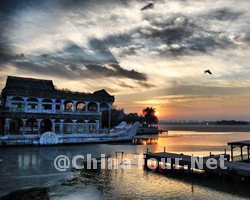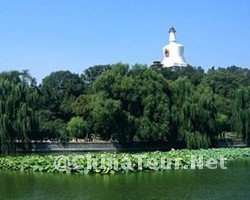Beijing has been the capital of China for over centuries. It was the imperial residence of loyal members of Ming and Qing Dynasty. The Forbidden City was the imperial palace of Ming and Qing Dynasty. The Summer Palace was the imperial garden of Qing Dynasty. There are other imperial attractions such as the Temple of Heaven, Jangshan Park etc. Beijing imperial attractions are the national treasure of china.
The following is a list of Top 10 Beijing Imperial Attractions for reference.
1. The Forbidden City |
|
 |
Built about 600 years ago, the Forbidden City has played an important role in Chinese history. It was the imperial palace of Ming Dynasty and Qing Dynasty from Emperor Yongle. Have you ever wanted to catch a glimpse of the life of ancient emperors? This palace is definitely the answer. There are over 8000 rooms in the palace. The palace area is divided into two parts: the Outer Court and the Inner Palace.The Forbidden City was the largest collection of preserved ancient wooden structures in the world. >>More |
2. The Summer Palace |
|
 |
The Summer Palace is the largest and best-preserved royal garden in China. It is a blend of natural scenery and artificial landscape. The mountains, waters and architecture together form picturesque scenes that are amazingly beautiful. UNESCO declared the Summer Palace “a masterpiece of Chinese landscape garden design. The natural landscape of hills and open water is combined with artificial features.” It is a popular tourist destination but also serves as a recreational park. >>More |
3. The Temple of Heaven |
|
 |
The Temple of Heaven is a complex of religious buildings where the emperors came every winter solstice to worship heaven and to solemnly pray for a good harvest. Built about 600 years ago, it is the most holy imperial temple in Beijing. It was inscribed as a UNESCO World Heritage Site in 1998 and was described as “a masterpiece of architecture and landscape design which simply and graphically illustrates a cosmogony of great importance for the evolution of one of the world’s great civilizations…” >>More |
4. Jingshan Park |
|
 |
Jingshan Park is located to the north gate of the Forbidden City. It was once part of the Forbidden City until 1900s. You can get the best view of Beijing from the Pavilion of Everlasting Spring (Wanchun Pavilion). You can enjoy a bird’s eye view of the Forbidden City, piles of golden roofs stretching into the distance. The 45.7-metre high artificial hill was constructed in the Yongle era of the Ming Dynasty entirely from the soil excavated in forming the moats of the Imperial Palace and nearby canals. It is especially impressive when one considers that all of this material was moved only by manual labor and animal power. >>More |
5. Ming Tombs |
|
 |
The Ming Tombs are the mausoleums of 13 emperors of the Ming Dynasty (1368 – 1644). The harmonious integration of remarkable architectural groups in a natural environment chosen to meet the criteria of geomancy (Fengshui) makes the Ming Imperial Tombs masterpieces of human creative genius. So far, three of them are open to the public. They are Changling Tomb, Dingling Tomb and Zhaoling Tomb. Dingling Tomb is the only tomb of the thirteen to be excavated.>>More |
6. Imperial College |
|
 |
The Imperial College (Guozijian in Chinese) was the national central institute of learning in ancient Chinese dynasties. It was the highest institute of learning in China’s traditional educational system. Emperors in imperial China would also frequently visit the Guozijian to read Confucian classics to thousands of students. |
7. Yonghegong Lama Temple |
|
 |
Yonghegong Lama Temple is by far the most colourful temple in Beijng with beautiful rooftops, stunning frescosm, taperstries, incredible carpentry and a great pair of Chinese lions. Historically, the Yonghegong Lama Temple was a residence for Emperors Yongzheng and Qianlong of the Qing Dynasty. In the 9th year of Qianlong’s reign (1744), it became a temple of the Lama Buddhist sect. |
8. Fragrant Hills Park |
|
 |
Fragrant Hills Park covers 1.6 km² (395 acres) and consists of a natural pine-cypress forest, hills with maple trees, smoke trees and persimmon trees, as well as landscaped areas with traditional architecture and cultural relics. The name derives from the park’s highest peak, Xianglu Feng (Incense Burner Peak), a 557 meters (1827 ft) hill with two large stones resembling incense burners at the top. >>More |
9. Temple of the Sun |
|
 |
The Temple of the Sun is located in Chaoyang District, Beijing, China. It is within Ritan Park, in the Jianguomen area. The nearest Beijing Metro station is Yonganli on the Beijing subway Line 1. The temple’s altar was built in 1530 during the late Ming Dynasty for use in ritual sacrifice to the sun by the Emperor of China. The area surrounding the Ritan temple is now a public park, and the site features extensive gardens and a small lake. >>More |
10. Beihai Park |
|
 |
Beihai Park is one of the oldest, most representative and best-preserved ancient loyal gardens in China. It is a perfect integration of magnificent imperial palaces and solemn religious constructions. Here you can enjoy the unique scenery of artificial hills, pavilions, halls, temples, long corridors blended with trees, hills and waters in a harmoney of man and nature. >>More |
Recommended Beijing local tours:
1 Day Tour: Great Wall, Tian’anmen Square, Forbidden City, from $43
1 Day Tour: Forbidden City, Temple of Heaven, Summer Palace, from $39
2-Day Tour: Forbidden City, Tian’anmen Square, Temple of Heaven, the Great Wall, Ming Tombs Hotel Package, from $238.
3-Day Tour: Tian’anmen Square, Forbidden city,Temple of Heaven, the Great Wall, Ming Tombs,Beijing Hutong, Summer Palace, from $192. >>More Beijing Tours